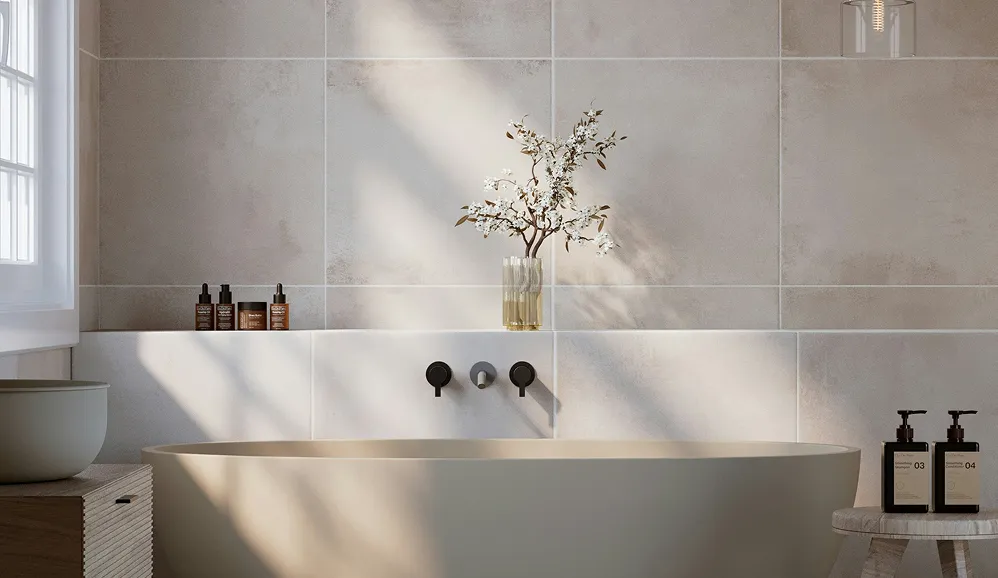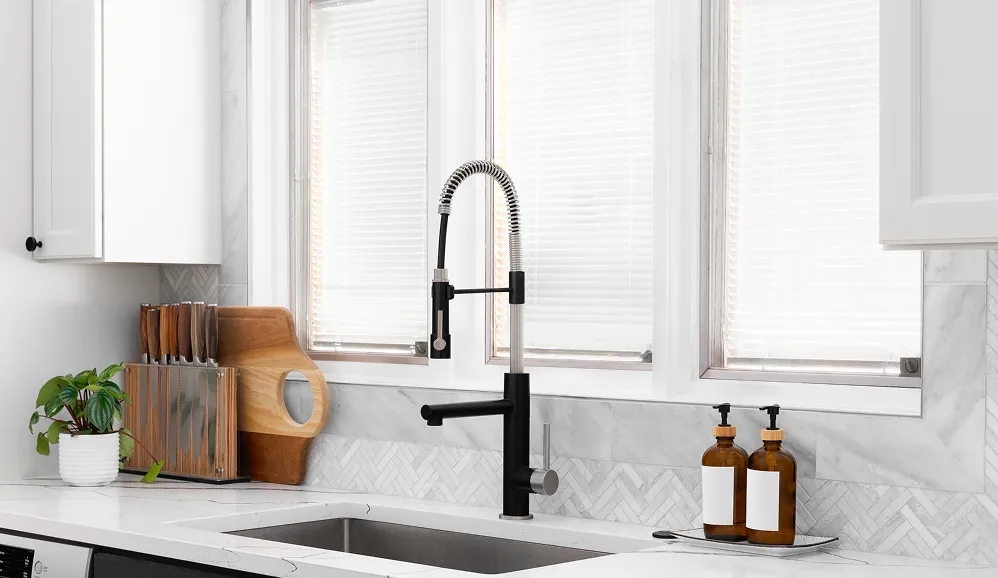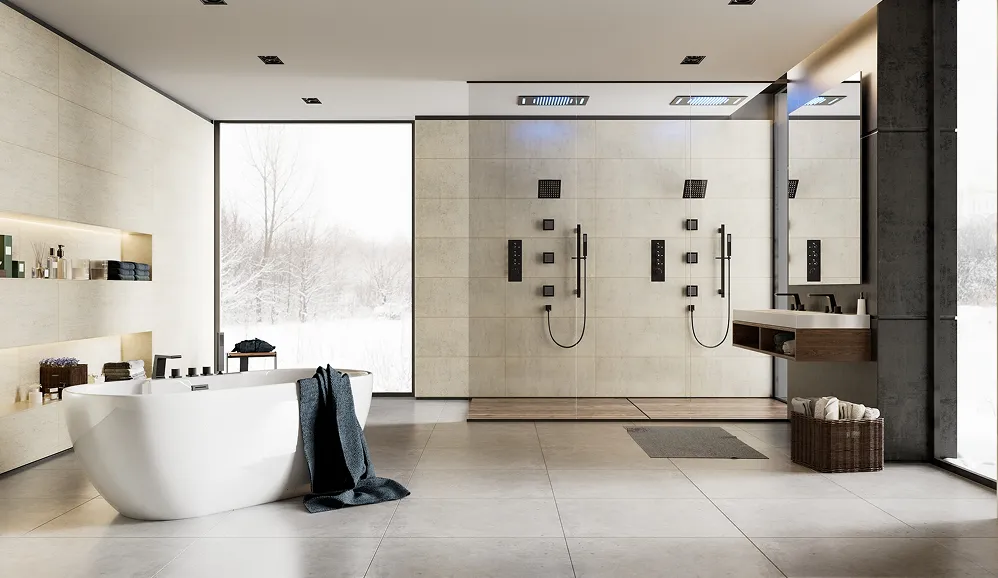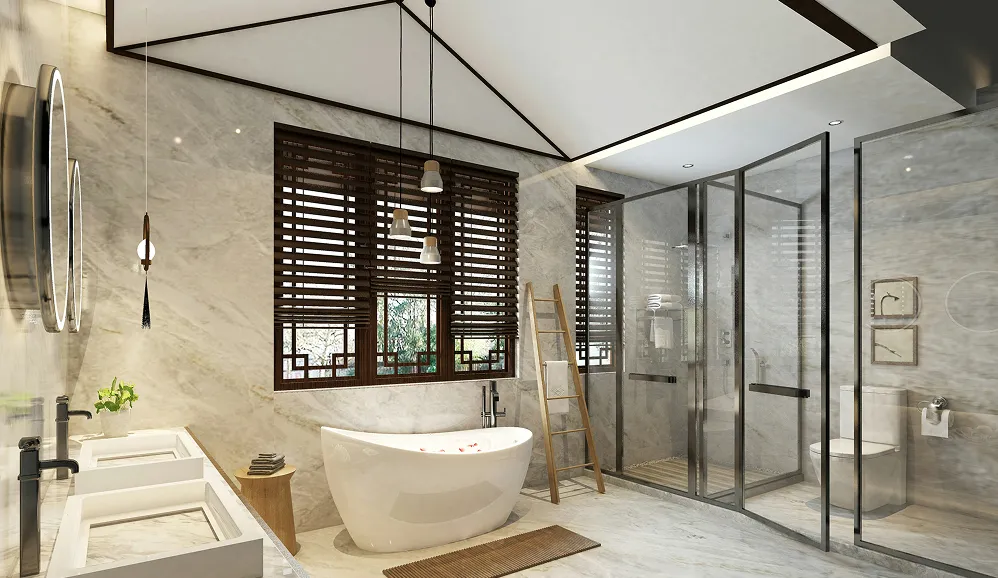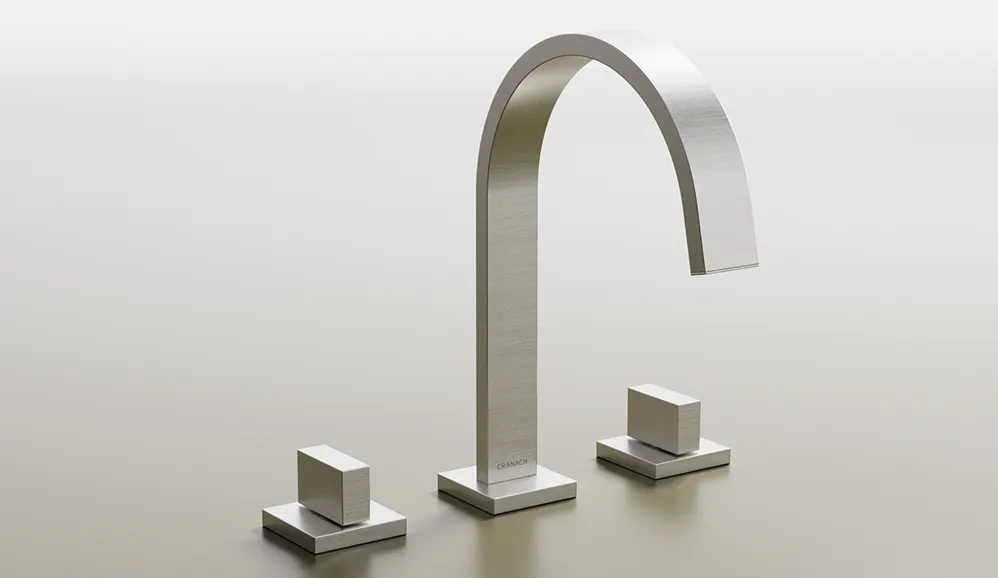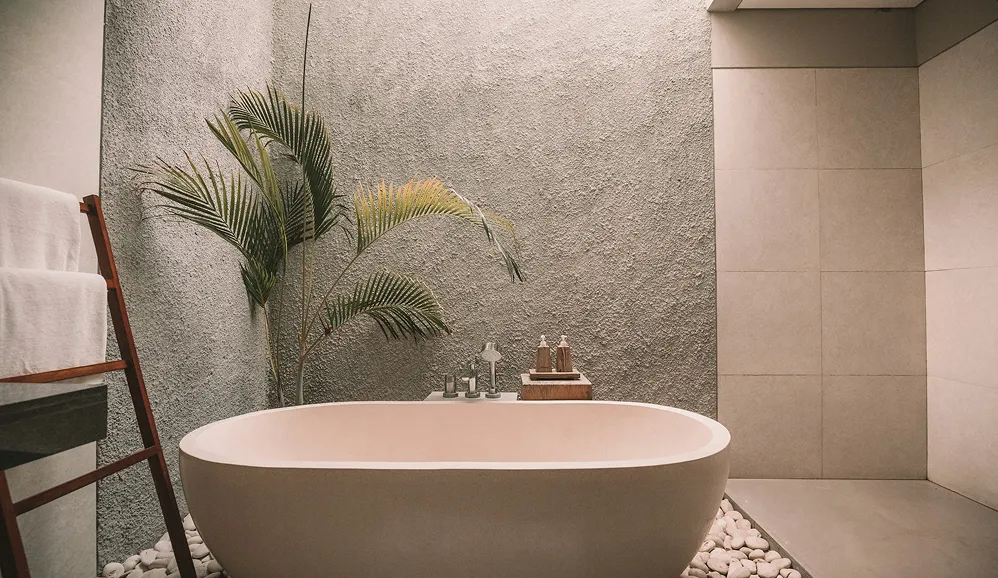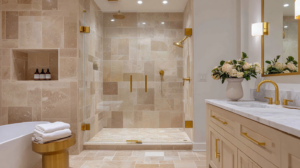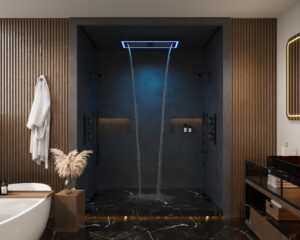Let’s get right to it: a typical shower in the US uses about 17 gallons of water and lasts just a little over eight minutes. But that’s just an average. The two things that really matter—and that you have complete control over—are your shower’s flow rate and how long you let the water run.
Grasping this simple relationship is the key to managing both your home’s water footprint and your monthly utility bills.
Your Shower’s Water Footprint Explained
Think of your shower like a hose filling up a bucket. The stronger the stream and the longer you leave it on, the faster that bucket gets full. It’s the exact same principle at play every morning. How much water you use boils down to just two things: how much water your showerhead puts out and how long you stand under it.
That average American shower? It uses about 17.2 gallons over roughly 8.2 minutes, which means the flow rate is about 2.1 gallons per minute (GPM). This daily habit adds up faster than you’d think. For one person, that’s around 120 gallons of water each week.
Over a full year, a single person will use roughly 6,261 gallons just for showering. For a family of four, that number can balloon to over 25,000 gallons annually.
The Two Core Components of Water Usage
The beauty of figuring this out is how simple it is. It all comes down to two factors:
- Flow Rate (Gallons Per Minute): This is just how much water your showerhead lets out every minute it’s on. Older, outdated fixtures can be real water-guzzlers, sometimes pushing out 5 GPM or more. Modern, high-efficiency models, on the other hand, are designed to use 2.5 GPM or less without sacrificing that great shower feel.
- Shower Duration (Minutes): This one is easy—it’s how long you keep the water running. It’s also the factor you can change right now, today, without spending a dime.
Once you see how these two work together, you can start making small tweaks that lead to big savings. For a more detailed breakdown, you can check out our complete guide on how many gallons of water a shower uses.
Here’s something most people forget: the water used in your shower doesn’t just show up on your water bill. It hits your energy costs, too. Heating water is often the second-biggest energy expense in a home, accounting for about 18% of the average utility bill.
Putting It All Together
So, how do you calculate your own usage? It’s simple multiplication: Flow Rate (GPM) x Duration (Minutes) = Total Gallons Used.
If you take a 10-minute shower with a standard 2.1 GPM showerhead, you’ve used 21 gallons. If you cut that time down to just 5 minutes, you instantly save 10.5 gallons. It’s that straightforward.
To give you a clearer picture, here’s a quick reference table showing how the minutes add up.
Shower Water Usage at a Glance
This table shows the estimated water consumption for different shower durations using a standard 2.1 GPM showerhead. It’s a quick way to see how a few extra minutes can make a big difference.
| Shower Duration (Minutes) | Water Used (Gallons) |
|---|---|
| 5 Minutes | 10.5 Gallons |
| 8 Minutes | 16.8 Gallons |
| 10 Minutes | 21.0 Gallons |
| 15 Minutes | 31.5 Gallons |
| 20 Minutes | 42.0 Gallons |
As you can see, doubling your shower time from 10 to 20 minutes also doubles your water consumption. Being mindful of the clock is one of the most powerful water-saving tools you have.
This basic idea is the foundation for making smarter choices about your bathroom. Upgrading to efficient shower systems or a new shower kit can permanently lower your flow rate, while being conscious of time provides daily opportunities to conserve. Even simple shower sets can make a huge impact on your home’s overall efficiency. By understanding the link between flow, time, and total use, you gain direct control over both your water and energy bills.
How to Calculate Your Shower’s Water Consumption
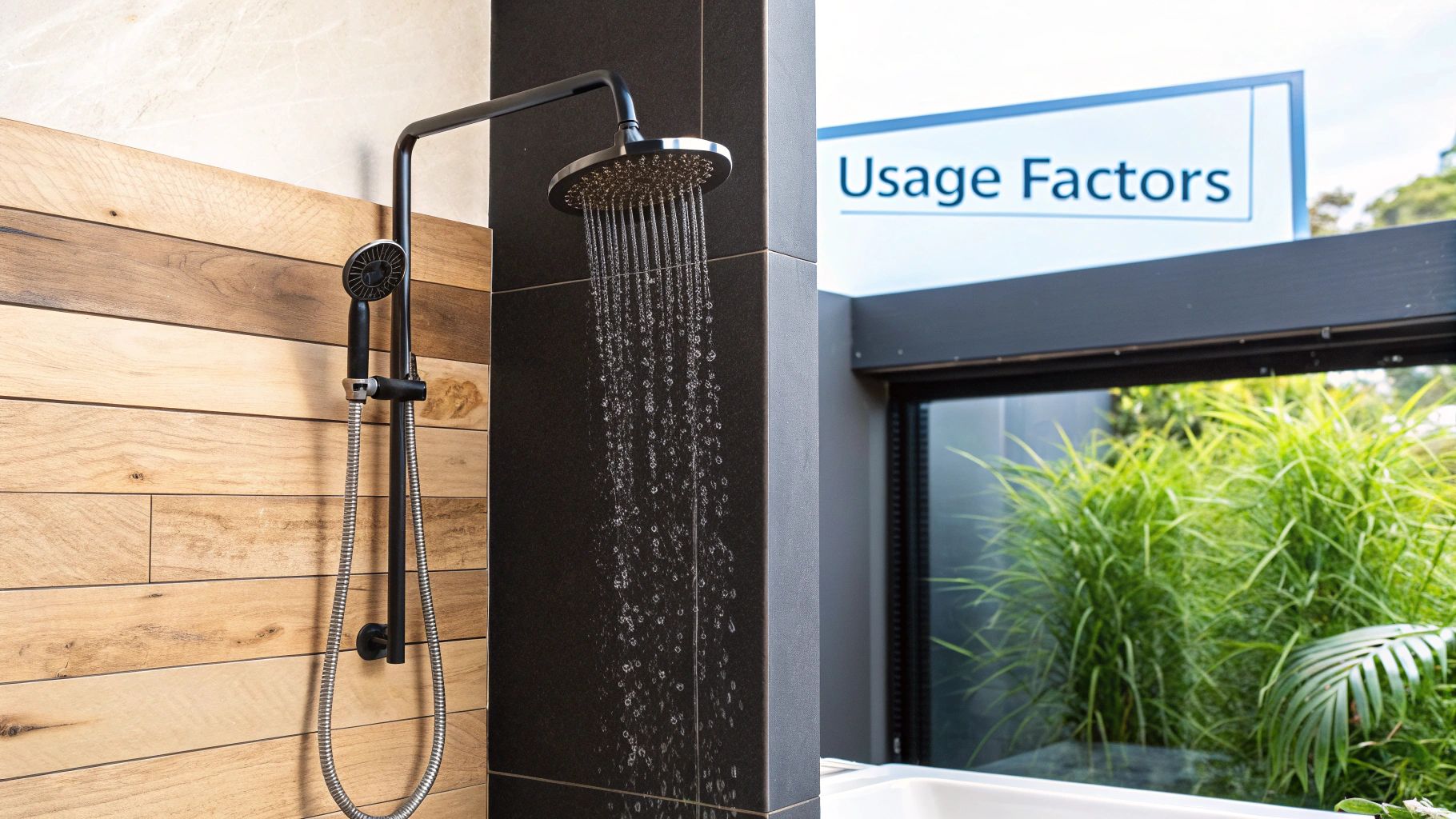
While national averages are a good starting point, knowing your home’s exact water usage is where the real power lies. It’s one thing to hear about general statistics; it’s another to see precisely how much water your own shower is sending down the drain.
Fortunately, moving from estimates to personalized data is surprisingly simple. You don’t need fancy equipment or a plumber on speed dial. All it takes is a quick, hands-on method called the “bucket test” to find out exactly how many gallons your shower uses.
The Simple Bucket Test
Ready to find out your shower’s flow rate in gallons per minute (GPM)? This quick exercise cuts through the technical jargon and gives you a real, tangible number to work with.
All you need is a bucket (preferably one with gallon markings) and a stopwatch—your phone’s timer is perfect for this.
- Grab a one-gallon bucket and place it directly under your showerhead.
- Turn the shower on to the same pressure you would for a normal shower.
- Start your stopwatch the instant the water begins filling the bucket.
- Stop the timer the second the water hits the one-gallon mark.
That’s it! Now, take a look at the time. Did it take around 20 seconds to fill the gallon? If so, you likely have a high-flow showerhead. If it was closer to 30 seconds, you’re in the standard flow rate territory. This one little number is the key to understanding your home’s water consumption.
From Test to Total Gallons
With your time in hand, a little bit of simple math will reveal your GPM.
The formula is straightforward: 60 / (seconds to fill one gallon) = GPM.
Let’s say it took 24 seconds to fill your bucket. You’d calculate it like this:
60 / 24 = 2.5 GPM
This means your showerhead puts out 2.5 gallons of water for every single minute it’s running. Armed with this knowledge, you can now see the direct link between your daily habits and your utility bills. If you’re curious how that stacks up against modern, efficient models, you can explore the advantages in our guide to the best low-flow shower heads.
The Final Formula: GPM x Shower Time = Total Gallons Used
Let’s put it all together. Using that 2.5 GPM we just figured out, an average 8-minute shower suddenly has a clear, measurable impact:
2.5 GPM x 8 minutes = 20 gallons
Suddenly, that abstract idea of “water usage” becomes a concrete 20-gallon reality.
Understanding this calculation empowers you to make changes that actually matter. Whether you decide to shorten your showers or upgrade to more efficient shower systems, you’re no longer just guessing. Upgrading to a modern shower kit or even simple shower sets can make a huge difference by lowering your GPM from the start—giving you permanent, built-in savings without having to change your routine at all.
How Showerhead Technology Impacts Water Use
The single biggest factor determining how many gallons your shower uses isn’t just how long you stand under the water—it’s the technology inside the showerhead itself. Not all fixtures are created equal, and the difference between an old, outdated model and a modern, efficient one is honestly staggering. An inefficient showerhead can completely cancel out your best efforts to take shorter showers.
Think about it this way: a showerhead from before the 1990s could easily gush water at 5.0 gallons per minute (GPM), sometimes even more. At that rate, an average 8-minute shower becomes a 40-gallon deluge. When you compare that to what’s possible today, you’ll see why a simple fixture upgrade is one of the smartest changes you can make in your home.
The Rise of Water-Saving Fixtures
As awareness around water conservation grew, the federal government stepped in. New mandates now require that showerheads have a flow rate no higher than 2.5 GPM. The problem? Millions of homes still have those older, water-guzzling models installed. Worse yet, some people modify their fixtures, pushing the flow rate to as high as 5.5 GPM. A 12-minute shower with one of those could use an incredible 60 gallons of water.
This is where today’s technology really shines. Modern fixtures, especially those with the EPA’s WaterSense seal, are designed to give you a great shower experience using 2.0 GPM or less.
But how do they do it without feeling weak? The secret isn’t just restricting the water flow; it’s about smarter design. These showerheads use aeration to mix air into the water stream. This clever trick creates larger, lighter droplets that feel just as powerful and give you fantastic coverage, all while using a fraction of the water.
Upgrading for Efficiency and Experience
Choosing to upgrade your bathroom with modern shower systems is about so much more than just saving water—it’s about improving your entire daily routine. Today’s high-quality shower sets are engineered from the ground up to deliver a superior experience, blending that luxurious, high-pressure feel with smart, sustainable performance.
Many homeowners hesitate to switch, worried they’ll be stuck with a weak, unsatisfying trickle. But that’s a problem technology solved a long time ago. You absolutely can get a powerful, invigorating shower while racking up major water and energy savings. In fact, if your current pressure feels a bit lackluster, there are often simple ways to fix it. You can learn all about them in our guide on how to increase water pressure in your shower.
Investing in a complete shower kit ensures that every component is designed to work together perfectly. This integrated approach is the best way to maximize both efficiency and comfort, proving you really don’t have to choose between a great shower and a responsible one. You can have both.
The Hidden Costs of a High-Flow Shower
That long, hot shower might feel like a daily luxury, but its true cost is hiding in plain sight on your utility bills. The price you pay for high water usage is a one-two punch: the cost of the water itself and, often more significantly, the cost of the energy needed to heat it. This second expense is a major hidden drain on many household budgets.
So, when you ask, “how many gallons of water does a typical shower use?” you’re also asking how much energy you’re burning. Every extra gallon of hot water swirling down the drain is literally wasted energy, and it adds up to a steep financial and environmental price over the year.
The Financial Drain of Wasted Water
It’s a straight line from your showerhead to your wallet. In many areas, sticking with old, inefficient fixtures can seriously inflate your bills. For instance, in Canada, where showering accounts for about 17% of all indoor water use, a home with an old-school showerhead gushing at 5 gallons per minute could be looking at annual water charges of up to $750.
Making the switch to a modern, water-efficient model is one of the smartest, simplest upgrades a homeowner can make. It’s an investment that often pays for itself in less than a year by slashing both water and energy costs. This infographic drives home just how fast the savings from a quick swap can pile up.
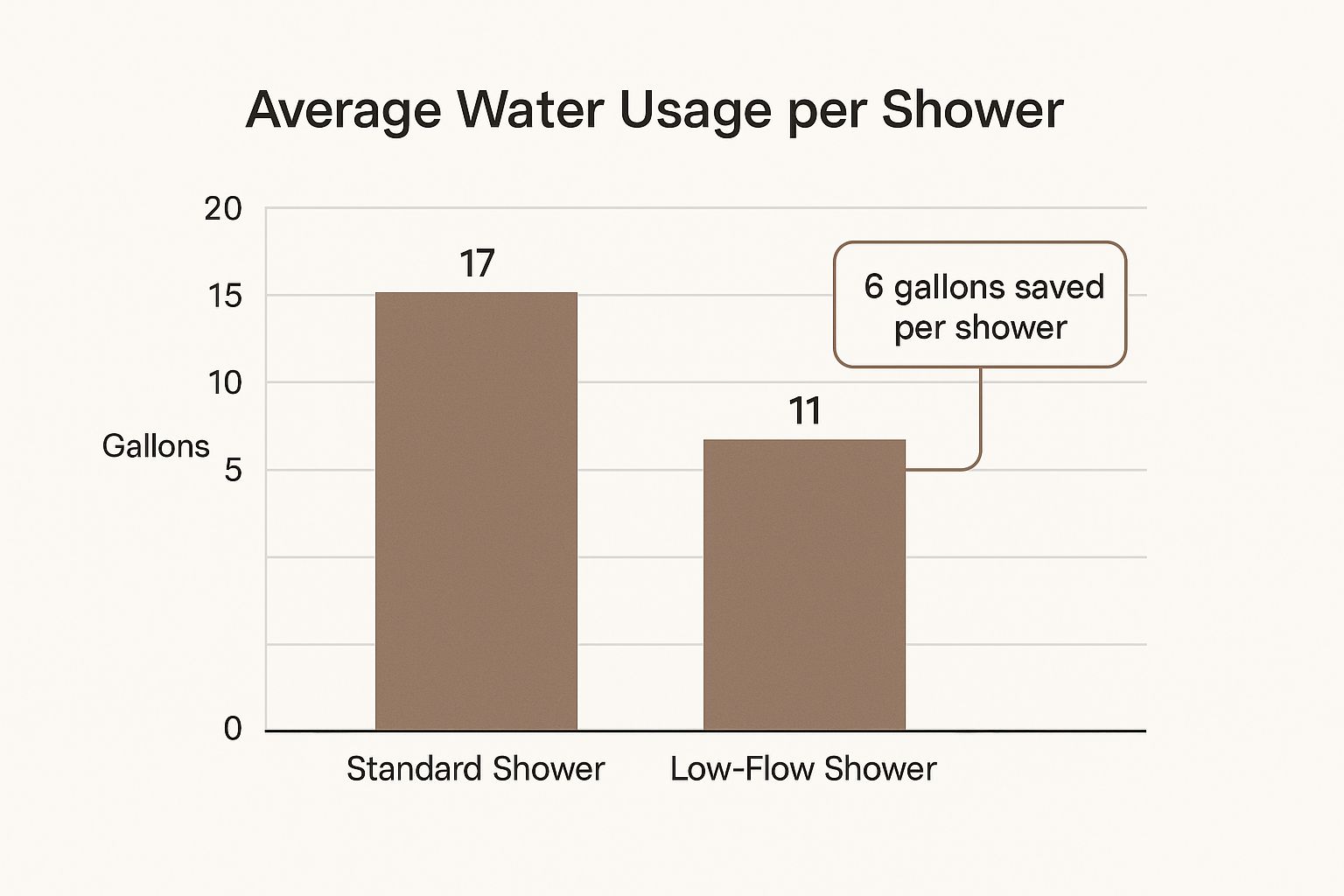
As the chart shows, even a small reduction in flow rate saves a whopping 6 gallons of water with every single shower.
To put this into perspective, let’s look at the real-world annual costs for a family of four.
Annual Showering Cost: Standard vs. Water-Saving Showerhead
| Feature | High-Flow Showerhead (5.0 GPM) | WaterSense Showerhead (2.0 GPM) |
|---|---|---|
| Water Used Per Shower (8 min) | 40 Gallons | 16 Gallons |
| Annual Water Use (Family of 4) | 58,400 Gallons | 23,360 Gallons |
| Estimated Annual Water Cost | $409 | $163 |
| Estimated Annual Energy Cost | $390 | $156 |
| Total Estimated Annual Cost | $799 | $319 |
The difference is staggering, isn’t it? Switching to a water-saving showerhead could put nearly $500 back into your pocket each year, all while using 60% less water and energy.
Beyond the Bill: An Environmental Perspective
The impact of all that extra water goes far beyond your bank account. The massive amount of energy required to pump, treat, and heat water for millions of homes puts a significant strain on our environment.
By choosing efficient fixtures, you’re not just saving money—you are actively reducing your home’s energy demand and conserving a vital natural resource.
This makes upgrading your bathroom a powerful win-win. Installing a modern shower kit or one of today’s integrated shower systems can permanently shrink your household’s environmental footprint without you having to change your daily routine. Even just swapping out an old fixture for new shower sets makes a real, measurable difference.
Making a conscious choice to install water-saving technology is a simple way to align your home with both fiscal responsibility and ecological mindfulness. It’s a small change that delivers big returns, both for your budget and for the planet.
Practical Ways to Reduce Your Shower Water Usage
Now that you see the real cost hiding behind a high-flow shower, you’re probably ready to do something about it. The great news is that cutting back on your daily water use doesn’t mean you have to rip out your bathroom or totally upend your lifestyle. It all comes down to a few simple changes in your habits and some low-cost upgrades that, when you put them together, make a huge difference.
It’s the small, consistent actions that lead to big savings. You don’t have to give up the simple pleasure of a warm shower; you just need to be a bit smarter about how you use that water. Let’s walk through some practical, easy-to-implement tips that will start saving you water and money right away.
Master Your Shower Routine
The fastest changes you can make won’t cost you a penny. They just require you to be more aware of how long the water is actually running.
-
Time Your Showers: The easiest trick in the book is to just set a timer. Aiming for a 5-minute shower is a fantastic goal. If you typically take an 8-minute shower with a standard 2.1 GPM showerhead, trimming it down to five minutes saves 6.3 gallons every single day. That adds up to over 2,000 gallons of water saved per person in a year.
-
Try a “Navy Shower”: This technique is incredibly effective and straightforward. Turn the water on to get wet, then turn it completely off while you lather up with soap or work in your shampoo. Once you’re ready to rinse, flip it back on. This simple on-off-on process can slice your water-running time in half, or even more.
These habits directly tackle the “duration” part of the water usage equation, putting you in immediate control of how much you use.
Simple Upgrades for Big Gains
Beyond tweaking your routine, a few small hardware adjustments can put your water savings on autopilot. These are often cheap and easy to install, making them perfect for a quick weekend project. In fact, many modern shower systems already come with these smart features built right in.
A brilliant option is to install a showerhead with a pause button or a trickle valve. This little device lets you temporarily stop the flow down to a light trickle while you lather, shave, or let conditioner sit—all without messing with the water temperature. It’s the best of both worlds: the convenience of having your hot water ready to go and the efficiency of a Navy shower.
And if you’re worried that a new, more efficient fixture might kill your water pressure, don’t be. Most people find the pressure is perfectly fine, but if it does feel a little weak, there are often simple ways to fix it. We cover some great solutions in our guide on how to increase water pressure in a shower.
By combining a shorter shower with an efficient fixture, you’re tackling both sides of the consumption problem—flow rate and duration. This dual approach is the most powerful strategy for minimizing your shower’s water footprint.
Ultimately, knowing how many gallons of water does a typical shower use gives you the power to see where your efforts will count the most. Whether you start by timing your next shower or look into upgrading your entire shower kit, every step you take makes your home a little more sustainable. And for anyone wanting an all-in-one solution, modern shower sets are a great way to guarantee both a fantastic experience and top-notch efficiency from day one.
Your Path to a More Efficient Shower
So, where do we go from here? It all comes together with this simple truth: understanding and controlling how many gallons of water a typical shower uses is one of the most direct ways you can lower your utility bills and conserve a precious resource.
We’ve walked through how to measure your own water use, seen the difference modern technology can make, and shared a few easy habits that add up to a big impact. Now, the next step is yours. You have the knowledge to make a real change, and you can start today. This isn’t about giving up a great shower; it’s about making a smarter, more responsible choice for your wallet and the planet.
Your Action Plan for Savings
Whether you decide to make a small change in your routine or go for a full hardware upgrade, every little bit counts. The path forward is clear, and you can start with whatever feels right for you.
- Time Your Next Shower: Seriously, just try it. Challenge yourself to shave off two minutes. It’s a completely free way to see an immediate drop in your water and energy bills.
- Do the Bucket Test: Stop guessing and get the real numbers. Taking a few minutes to find out your showerhead’s actual gallons per minute (GPM) is the only way to know your home’s true water footprint.
- Explore Efficient Fixtures: If you’re ready for a change, think about upgrading your hardware. The latest high-efficiency shower systems are designed to give you that luxurious, high-pressure feel without all the waste.
The most powerful insight is realizing that efficiency and comfort are no longer mutually exclusive. Modern shower sets and a complete shower kit are engineered to deliver robust pressure while using significantly less water.
Ultimately, taking control of your shower’s water use puts you in the driver’s seat. You’ve got the tools and the info you need to shrink your bills, lessen your environmental impact, and make your daily routine that much better. The choice to build a more efficient, sustainable home is in your hands.
Frequently Asked Questions
When you start looking into water-saving fixtures, a few questions always pop up. It’s natural to wonder if you can really have an amazing shower while still being mindful of your water use. Let’s tackle some of the most common concerns right now.
Do Water-Saving Showerheads Provide Good Water Pressure?
Absolutely. It’s one of the biggest myths out there, but modern water-saving showerheads are designed with smart aerodynamics. They work by mixing air into the water stream, which creates the feeling of a powerful, full-pressure spray. You don’t have to choose between a satisfying shower and an efficient one.
Of course, keeping your fixture clean is also essential for top performance. Mineral buildup can clog the nozzles over time and weaken the flow, but you can easily restore its power when you how to clean your shower head with vinegar.
What Is the Ideal Shower Length to Save Water?
The average American shower runs for just over eight minutes, but if you’re looking for a great conservation goal, aim for a 5-minute shower. It’s a small change that makes a huge difference.
By trimming just three minutes off your daily routine, a single person with a standard showerhead can save over 2,000 gallons of water a year. That adds up fast!
How Quickly Does a New Shower System Pay for Itself?
You’d be surprised how fast the return on investment is. For a family of four switching from an old, high-flow fixture to modern, efficient shower systems, the savings on water and heating bills start immediately.
Many people find that their new shower kit or shower sets pay for themselves in less than a year. It’s one of those rare home improvements that’s great for your wallet and the planet.
Ready to transform your shower into a model of efficiency and luxury? Explore the innovative Cranach shower systems that deliver a premium experience while conserving water.

